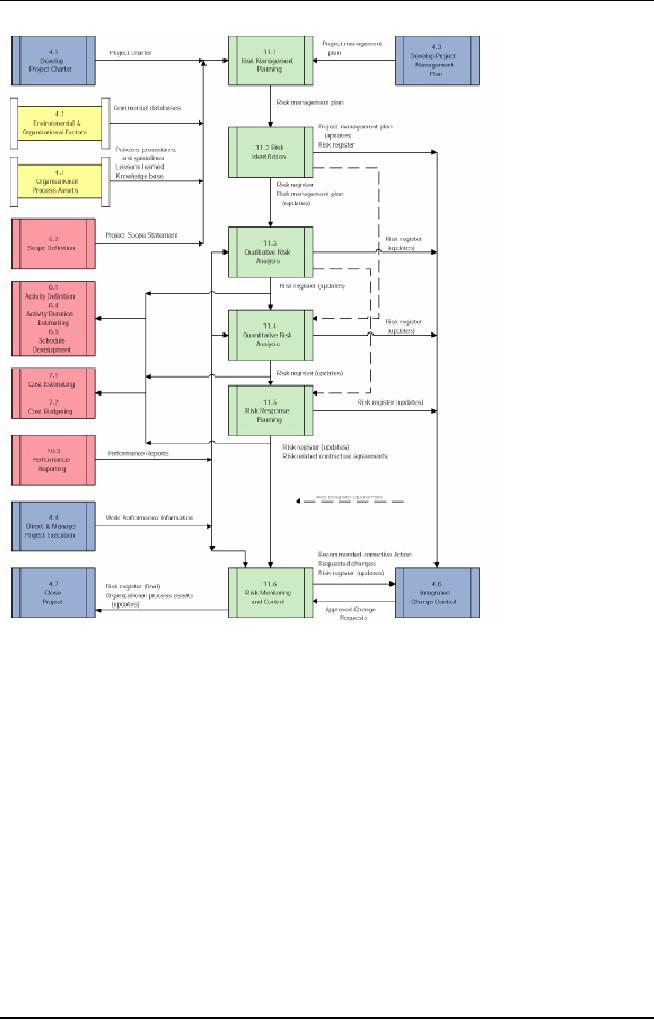 |
Risk and Change Management: Risk Management Concepts |
| << Scheduling Tools: GANTT CHARTS, PERT, CPM |
| Risk & Change Management Concepts >> |

Software
Project Management
(CS615)
LECTURE
# 39
9.
Risk and Change
Management
9.1
Risk is
defined as the possibility of
loss. It is the inability to
achieve program
objectives
within defined cost,
schedule, and technical constraints.
Risk
management is a
set of actions that helps
the project manager plan an approach
to
deal with
uncertain occurrences.
A
software project encounters
two types of risks,
development process risks
and
product-
related risks. Some of the
development process risks
are developer
errors,
natural disasters, disgruntled
employees, and poor management
objectives.
Some
project related risks are
incomplete requirements, unclear
project
deliverables
and objectives, and complexity of the
product.
The
steps of risk management involve
risk identification, risk
analysis, and risk
mitigation.
Risk identification involves
identifying risks. Risks are
identified after
discussion
with team members about the
requirements documents,
available
technology,
resources, and other project-related
factors.
Contingency
planning involves maintaining an
alternative plan if the
original plan
fails.
Contingency plans are put to
use when risks become a
reality.
What
is it? Risk
analysis and management are a series of
steps that help a
software
team to understand and manage
uncertainty. Many problems can
plague
a
software project A risk is a
potential problem - it might happen, it
might not But
regardless of
the outcome, it's a really
good idea to identify it,
assess its
probability
of occurrence, estimate its impact, and
establish a contingency
plan
should
the problem actually
occur.
Who
does it? Everyone
involved in the software
process managers, software
engineers and
customers - participate in risk
analysis and management
Why is it
important? Think about the
Boy Scout motto: "Be
prepared" Software is
a
difficult undertaking. Lots of
things can go wrong, and frankly,
many often do.
It's
for this reason that
being prepared, understanding the
risks and taking
preventive
measures to avoid or manage
them is a key element of good
software
project
management.
What
are the steps? Recognizing
what can go wrong is the
first step, called -
risk
identification. Next, each
risk is analyzed to determine
the likelihood that
it
will
occur and the damage that it
will do if it does occur. Once
this information is
established,
risks are ranked by
probability and impact. Finally, a
plan is
developed
to manage those risks with
high probability and high
impact.
305

Software
Project Management
(CS615)
What
is the work product? A risk
mitigation monitoring and
management
(RMMM)
plan or a set of risk
information sheets is produced.
How do I ensure
that
I've done it right? The
risks that are analyzed and
managed should be
derived
from
thorough study of the people,
the product, the process and
the project. The
RMMM
should be revisited as the
project proceeds to ensure that
risks are kept up
to date.
Contingency plans for risk
management should be realistic.
9.2
Risk
Management Concepts
Ever
wondered why people insure their
lives, their homes, their
cars, or their
valuables?
Suppose your house, along
with all the valuables, is
burgled. You will
be
definitely disheartened. However, you
will suffer less if all your
valuables are
insured.
At times such as these, you
realize the importance of
planning in advance
for
the uncertain events in your
life. Just as you plan for
unforeseen events in
your
life,
project managers also need to
prepare for uncertainties
affecting projects. All
project
management skills of a project manager
can fall in the face of
uncertainties
and unplanned problems.
Robert
Charette [CHA89] presents a
conceptual definition of
risk:
�
First,
risk concerns future
happenings, Today and yesterday
are beyond active
concern,
as we are already reaping
what was previously sowed by our
past
actions,
The question is, can we,
therefore, by changing our
actions today,
create an
opportunity for a different and
hopefully better situation
for
ourselves
tomorrow
�
This
means, second, that risk
involves change, such as in changes of
mind,
opinion,
actions, or places
�
Third
risk involves choice, and
the uncertainty that choice
itself entails, thus
paradoxically,
risk, like death and taxes, is one of the
few certainties of
life,
When
risk is considered in the context of
software engineering, Charette's
three
conceptual
underpinnings are always in
evidence. The future is our
concern
what
risks might cause the
software project to go awry? Change is
our concern -
how will
changes in customer requirements,
development technologies,
target
computers,
and all other entities
connected to the project
affect timeliness and
overall
success? Last, we must
grapple with choices - what
methods and tools
should we
use, how many people should
be involved, how much
emphasis on
quality
is "enough"?
Any
project can encounter uncertainties in
the form of increased costs,
schedule delays,
and
diminished qualities. Unless
tackled, these uncertainties can lead to
major project
disasters.
The uncertainties encountered
during project execution are
the potential project
risks.
Every software project has
to grapple with the new
risks threatening
information
306

Software
Project Management
(CS615)
security
along with the conventional
risks, such as hardware
failure, time and cost
escalation,
defects, or resource crunch. Risk can be
defined as the possibility of
loss. Risk
arises
due to the inability to achieve
objectives within defined
cost, schedule, and
technical
constraints. Risk has two
components. The possibility of
not achieving a
particular
outcome is one, and the
result of failing to achieve
the outcome is the
other.
The
former is the probability of
loss, and the latter is the
loss. Software
project
management
deals with managing both
these components of
risk.
According
to the risk management guru
Barry Boehm, "Risk
management focuses the
project
manager's attention on those portions of
the project most likely to
cause trouble
and
compromise participants' win
conditions." In other words,
risk management is a set
of
actions that helps the
project manager plan to deal with
uncertain occurrences. It is
through
risk management that project
managers assess risks and
manage to reduce risks
to an
acceptable level.
Software
risk management is not about
managing risks faced by a software
organization.
Here,
the focus is on managing
risks encountered during
software development
process.
Therefore,
the concern is about
managing the future of a
software project.
In this
chapter, you will 1ook at
the unforeseen events that
might affect a
software
project.
You will also learn about the
steps for managing and
mitigating software
project
risks.
Types
of Risks
To be able to
manage project risks, you
must first understand what
constitutes, a risk. All
uncertain
occurrences are not risks.
Only those occurrences that
have an adverse
impact
on the
progress of a project are
risks to the project. Risk
is not a bad thing. Risk is
bad
only
when it results in loss for an
organization. Unless there is a
potential for loss,
there
is no
risk. Moreover, loss can be interpreted
as either a bad outcome or a
lost opportunity.
The
tendency of most project
managers is to jump at the
statement this is a
risk.
However,
the desired reaction is to
pre-empt all possible outcome and
plan for them.
Project
risks can be broadly categorized into
development process risks and
product risks.
Development
Process Risks
The
risks encountered during
product development are
categorized as development
process
risks. These comprise developer
errors, natural disasters,
disgruntled employees,
and poor
management objectives.
Developer
errors could be attributed to
poor training due to budgetary
constraints and
inadequate
skills and software tools.
Ergonomic problems, environment
problems, and
interruptions
or distractions at office also account
for developer risks. Other
risks in this
category
include problems in personnel
acquisition and retention.
Similarly,
natural disasters such as
flood, cyclone, fire, storm,
and snowfall are also
risks
to a
project.
Disgruntled
employees can also become a risk to an
organization. For example, a
sacked
employee
can use password snuffers to gain
unauthorized access. A dismissed person
can
307

Software
Project Management
(CS615)
flood
the system with senseless
messages. A disgruntled employee can also
try to
sabotage
the project work by
destroying files and
programs.
A poorly
defined management objective is another
development process risk. If
the
language
in the management objective is ambiguous
and not stated clearly, the
risk
management
program will not function
properly. Narrowly focused and
changing
objectives
that are not updated can also be
counted as risks. Lack of
contingency plans,
incomplete
cost estimates, and unrealistic schedules are also
potential risks in a
project.
Similarly,
unrealistic performance standards
are also potential risks to
the development
process.
Other possible risks include
contractual risks, technological
risks, and
inadequate
documentation of other concurrent
projects.
Product
Risks
Product
risks crop up in the form of
changing requirements during
product development.
Incomplete
and unclear requirements are a
risk to the product during
development.
Similarly,
problems in meeting design specifications
can also be categorized as risk to
product
development.
Risks
could arise if the project
deliverables or objectives are
not clearly defined or
if
technical
data is missing. The
possibility of several alternatives at
any given time
during
the
project is also a cause of concern. If
errors are not recognized
during the design
phase,
they could turn into
risks for the project.
Similarly, risks could arise
due to the size
and
complexity of the product or
while achieving client
acceptance of the
product.
Note:
The
key idea in risk management is
not to wait for a risk to
materialize and
become a
problem. The objective of
risk management is to ensure that for
each
perceived
risk, you know well in
advance how to tackle
it.
Risk
Management Process
Project
Risk Management includes the
processes concerned with
conducting risk
management
planning, identification, analysis,
responses, and control on a project.
The
objectives
of Risk Management are to
increase the probability and
impacts of positive
events
and decrease the probability and
impacts of events adverse to
project objectives.
The
process of risk management begins during
the analysis phase of
software
development
life cycle. However, the
actual process of managing
risks continues
throughout
the product development
phase. Risk management is a dynamic
process
because
it deals with the activities
that are yet to happen. Risk
management has a two-
fold
agenda. First, deciding
actions for preventing risks
from happening, and second,
deciding
actions for tackling risks
that materialize. Therefore,
risk management is all
about
pre-empting a risk, coming up
with a plan for resolving
the risk, and finally
executing
the plan.
Figure
6.1 displays the steps of
the risk management process.
Formally, articulated,
risk
management
process consists of three
steps:
1. Risk
identification
2. Risk
analysis
308

Software
Project Management
(CS615)
3. Risk
mitigation
Figure
6.1: Risk
Management Process
Risk
Management
Risk
Risk
Risk
Identification
Analysis
Mitigation
Risk
Probability
Risk
Avoidance
Risk
Impact
Risk
Monitoring
Risk
Factor
Contingency
Planning
Risk
Identification
In this
step, the project manager gathers
information about the
potential risks in
the
project.
The project manager plans
the strategies for avoiding
risks or controlling
them.
The
project team conducts brainstorming
sessions and discussions among team
members
about
the requirements document.
They discuss the available
technology, manpower,
prevailing
environment, and all project-related
factors. The project manager
picks up the
thread
from these and creates a
risk log. After the
risk log is prepared, the
project
manager
calls a meeting within the
team and technical experts to discuss
the risk log and
the
mitigation plans. An effective
way of identifying' risks is
using a questionnaire.
Table
6.1 displays
a sample risk identification
questionnaire.
Table
6.1: Sample
Risk Identification
Questionnaire
Yes/No/Not
Applicable
SN
Risk
Description
(NA)
A.
Product
Engineering
Are
requirements changing continuously
during
1)
product
development?
Do the
changing requirements affect
each of the
2)
following:
Quality
Functionality
Schedule
Integration
Design
Testing
309

Software
Project Management
(CS615)
3)
Are
the external interfaces
changing?
Are
the requirements missing or
incompletely
4)
specified?
5)
Are
there any missing
requirements?
Can these
requirements be incorporated into
the
6)
system?
Does
the client have unwritten
requirements or
7)
expectations?
8)
Is there
a way to capture these
requirements?
9)
Are
requirements unclear or in need of
interpretation?
Are
you able to understand the
requirements as
10)
written?
Will the
requirements lead to the product
the client
11)
wants?
Are
there any requirements that
may not specify
what
12)
the
client really wants?
B.
Product
Design
Do you
encounter problem in meeting
functionality
1)
requirements?
Are
there any specified
algorithms that may
not
2)
satisfy
the requirements?
Will the
design and/or implementation be difficult
to
3)
achieve?
Are
there any requirements or
functions that are
4)
difficult
to design?
C.
Reusability
1)
Are
you reusing the
program?
2)
Do you
foresee any problems in
documentations?
3)
Do you
foresee any problems in
performance?
4)
Do you
foresee any problems in
functionality?
The
sample questionnaire in Table 6.1
includes an exhaustive list of
risks that might be
encountered
during the progress of a
project. The answers to the
questions in the risk
identification
questionnaire enable the project manager
to estimate the impact of risks.
In
the
sample questionnaire Table 6.1,
the risks are categorized
under product
engineering,
product-design,
and reusability. From this
table, you obtain a list of
risks that are
relevant
to each
category. You compare the information
obtained from this table
with past results
and estimate
the criticality of risk. In
short, during risk
identification, you obtain
answers
to the
following queries:
�
Why
is
the risk important?
�
What
information
is needed to track the status of
the risk?
�
Who
is
responsible for the risk
management activity?
�
What
resources
are needed to perform the
activity?
�
What is
the detailed
plan to
improve the risk and / or
mitigate it?
310

Software
Project Management
(CS615)
Risk
Analysis
After
identifying the risks, the
project manager needs to analyze
the risks.
Uncertainty
and loss
are the two characteristics
of risk. The uncertainty
factor in risk means that
the
unknown
event mayor may not happen.
While analyzing risks, the
project manager needs
to
quantify the level of
uncertainty and the degree of
loss. Based on this, the
project
manager
plans schedules and costs. During
analysis, information on risk is
converted into
information
on decision-making. Analysis provides
the basis for the
project manager to
work on
the "right" risks.
Table
6.2: Risk
Analysis Table
Probability
of
Impact
on
Risk
Factor
Risk
Occurrence
Project
(Probability
x
Description
(0
1)
(1
10)
Impact)
Table
6.2 displays a risk analysis
format. There are various
tasks involved in
risk
analysis.
First, the WBS elements
are identified. One of the
tasks in the risk
analysis
phase is
to describe the risk. The
risk can be product-related,
process-related,
organization-related,
client-related, or
infrastructure-related.
Second,
the WBS elements are
evaluated to determine the
risk events. Then the
project
manager
quantifies the probability of
occurrence of risk. The
project manager can assign
probability
values between 0 and 1. For
example, a risk with a low
probability of
occurrence
is marked 0.2 while that
with a high probability of
occurrence is marked
0.8.
The
reason why a particular risk
has a high or low
probability depends on the
actual
circumstance
of the project.
Third,
the risks are rated
depending on their probability of
occurrence. Based on
the
probability
of risk, the project manager
identifies the impact of the
risk. The impact of
risk on
cost, schedule, and quantity
needs to be calculated and graded. The
impact of risk
can be
graded on a scale of 1 to 10, 1
being the lowest, and 10
being the highest.
Then
the risk factor is
calculated by multiplying the
probability of risk and the
impact of
risk.
Finally, each risk is
prioritized relative to other
risks. The risk factor is
used to
prioritize
the identified risks. For
example, the risk with a
probability value 0.1 and
an
impact
value 2 will have minimal
impact. While risks close to
probability value 0.8
and
with an
impact value 9 will have greater
impact. Therefore, the
project manager can
prioritize
risks based on the
probability and the impact of
risks. A risk that has a
high
impact
and low probability will not
absorb a significant amount of
the project manager's
time.
However, high-impact risks
with moderate to high probability will
catch the
attention
of the project manager.
311

Software
Project Management
(CS615)
Risk
Mitigation
Risk
mitigation is the best possible approach
adopted by the project manager to
avoid
risks
from occurring. The
probability of the risk
occurring and the potential
impact of the
risk can
be mitigated by dealing with
the problem early in the
project. Essentially,
risk
mitigation
involves three possibilities and
the project manager needs to adopt a
risk
mitigation
strategy aimed at them. The
three possibilities
include:
� Risk
avoidance
� Risk
monitoring
� Contingency
planning
Risk
Avoidance
To avoid
risks from occurring, the
project team prepares the
risk plan before
the
commencement
of the project. The project
team identifies the potential
risks and
prioritizes
them based on their
probability of occurrence and impact.
Then, the team
prepares
a plan for managing risks.
In most software projects,
this plan is popularly
called
the
risk management plan. Table
6.3 displays the format of a
risk management plan.
Table
6.3: Risk
Management Plan
Impact
Probability
Risk
on
Risk
of
Factor
Mitigation
Start
End
Project
Responsibility
Description
Occurrence
(Probability
Steps
Date
Date
(1
(0
1)
x
Impact)
10)
To
prepare the risk management
plan, the project team first
identifies and assesses
the
risks
associated with the project.
Then, the probability of
occurrence of each risk
is
estimated and
the possible impact is calculated. In
the plan, the probable cost
and damage
is also
quantified. The project team also
identifies the contingency
plans for all
the
identified
risks. The contingency plan
for each risk is based on
the project's defined
operational
software process. The plan
is modified throughout the
software development
life
cycle of the project based
on the changes taking place.
The contingency plan
also
includes
the cost, in terms of
effort, in carrying out the
plan. The software risks
identified
are
tracked, reassessed, and re-planned at
the end of each phase. The
project manager
revisits
the plan if significant
changes are introduced in
the software project.
Risk
Monitoring
As the
project proceeds, risk-monitoring
activities commence. It is not possible
to
monitor
closely all the risks
that are identified for
the project. For example, if
100 risks
are
identified for a project,
only top 20 risks are
monitored. There are
re-planning
checkpoints
where the information
obtained from monitoring the
risks is used to
refine
the
risk assessments and management
plan. The project manager
monitors the top 20
312

Software
Project Management
(CS615)
percent
of the factors that may
indicate the status of the
risks in the project. In the
case of
large
teams, the project manager also
needs to monitor the
attitude of the team members
and their
problems. This helps the
project manager monitor any possible
team-related
risks.
Besides
monitoring the top 20
percent of the risks, the
project manager needs to
monitor
the
mitigation steps also.
Consider an example. To ensure that
particular software is
browser-
independent, the software is
created on the lowest
compatible browser.
Such
software
will work on any browser
thus making it browser-independent.
Therefore,
mitigating
a project risk involves
working hard at reducing the
possibility that the
risk
will ever
occur. Mitigation includes
nearly all actions that a
project team takes to
overcome
risks. For example, choosing
a more expensive but proven
technology over, a
newer,
less expensive technology is a
step toward mitigating
project risks.
Contingency
Planning
The
possibility of contingency planning
arises when mitigation
efforts fail and risk
becomes a
reality. Contingency planning is
used to monitor risks and
invoke a
predetermined
response. According to the
plan, a trigger is set up.
If the trigger is
reached,
the contingency plan is put
into effect. Contingency
planning involves
maintaining
an alternative plan if the
original plan fails. A
simple example could be
the
savings
people make for a rainy day.
Contingency plans are a must
for the top 20
percent
of the
risks identified. These plans
are put to use after
the risks become a reality.
The
importance
of contingency planning can be realized
from this example. Despite
the
massive
attack on WTC, the stock
markets in the US resumed functioning
within a few
days.
This was possible because the
finance companies had backed up their
data and
information
on computers elsewhere. The
contingency planning of finance
companies
prevented
the risk of huge data loss
for the stock
market.
Managing
Risks: Case Study
Consider
a scenario. Your organization is a vendor
of software solutions. A bus
transport
company
the US wants you to develop
a Schedule Adherence system.
The team that will
develop
this software is new and the
platform selected for
development is also new to
your
organization. The project team
needs to be trained intensively
for this.
During
this project, the team is expected to
manage a large volume of
data. The team has
never had
any experience in managing
such a large volume of data.
The system also
needs to
use this data to generate
various MIS reports related to
delays or adherence of
bus
services.
The
performance requirement is less
than fifteen seconds for
all popular browsers.
Your
organization
is anticipating numerous requirement
changes during the
development
process.
The system needs to be
implemented across several
states in the country.
The
data
related to the system is
highly confidential because it can
provide an edge to
the
competitors.
Now, as a
project manager, you need to
prepare a risk management plan
for this project.
The
project starts on May 15 and should be
completed on November
15.
313

Software
Project Management
(CS615)
First,
you need to identify the
potential risks involved in
the project. The potential
risks to
the
project are described in
Table 6.4.
Table
6.4: Potential
Risks to a Project
Risk
Description
Inexperienced
staff
Performance
risk due to high volume of
data to be processed
Cross-browser
compatibility
Involvement
of new technology
Design
changes during
development
After
identifying the risks, you
need to estimate the probability of
their occurrence and
their
impact on product development.
Based on this, you calculate
the risk factor and
plan
the
mitigation steps.
Your
risk management plan is displayed in
Table 6.5.
Table
6.5: The
Risk Management Plan for
Building a Schedule Adherence
System
Impact
Probability
Risk
on
Risk
of
Factor
Mitigation
Start
End
Project
Responsibility
Description
Occurrence
(Probability
Steps
Date
Date
(1
(0
1)
x
Impact)
10)
Conducting
training
Inexperience
Project
sessions
before
May
July
0.8
3
2.4
Staff
Manager
the
need
15
15
commencement
of
project
Massive
tuning
of
architecture
Performance
Till
during
the
risk due
to
the
design
phase
May
high
volume
0.6
7
4.2
Architect
end
of
and
conducting
15
of data
to be
the
a proof
of
processed
project
concepts
for
the
design
Cross-
Using
the
May
Till
0.6
5
3.0
Developer
browser
lowest
15
the
314

Software
Project Management
(CS615)
compatibility
compatible
end
of
browser
for
the
development
project
Ensuring
all
details
pertaining
to
Till
the
technology
Involvement
the
Project
is
available and
of
new
0.5
5
2.5
May
end
of
Manager
keeping
in
technology
the
close
touch
project
with
the
technology
vendor
Designing
a
flexible
Till
Design
architecture
the
changes
that
can
May
0.6
8
4.8
Architect
end
of
during
accommodate
15
the
development
future
changes
project
and
enhancement
In Table
6.5, the risk factors
with high values are
the high priority risks.
Here, the high
priority
risks are design changes
during development, performance
risk due to high
volume of
data to be processed, and cross-browser
compatibility. The high
priority risks
need to
be monitored closely and continuously.
The rest of the risks can be
monitored
periodically.
Certain risks need
contingency planning despite
being low in the
priority
list.
For example, the risk due to
involvement of new technology is a
low priority risk.
However,
the probability of occurrence of
this risk is 0.5,
which is
fairly high. This
calls
for
contingency planning because
you may not be aware of all
the details of the
new
technology.
Suppose the system fails to
respond if the number of users
exceeds a certain
number.
In such a situation, you
need to have a contingency
plan ready. You need
to
discuss
with the vendor regarding a
workaround for such a
situation. The
workaround
should be
ready in the case of failure
of the system.
Robert
Charette [CHA89] presents a
conceptual definition of
risk:
First,
risk concerns future
happenings, Today and yesterday
are beyond active concern,
as
we are
already reaping what was
previously sowed by our past
actions, The question
is,
can we,
therefore, by changing our
actions today, create an
opportunity for a different
and
hopefully
better situation for
ourselves tomorrow, This
means, second, that risk
involves
change,
such as in changes of mind,
opinion, actions, or places...[Third]
risk involves
choice,
and the uncertainty that
choice itself entails, Thus
paradoxically, risk, like
death
and taxes, is one of
the few certainties of
life,
315

Software
Project Management
(CS615)
When
risk is considered in the context of
software engineering, Charette's
three
conceptual
underpinnings are always in
evidence. The future is our
concern what
risks
might
cause the software project
to go awry? Change is our concern
-how will changes in
customer
requirements, development technologies,
target computers, and all
other entities
connected
to the project affect
timeliness and overall success?
Last, we must grapple
with
choices -
what methods and tools
should we use, how many
people should be involved,
how
much emphasis on quality is
"enough"?
What
is it? Risk
analysis and management are a series of
steps that help a software
team
to
understand and manage uncertainty.
Many problems can plague a
software project A
risk is a
potential problem - it might happen, it
might not But regardless of
the outcome,
it's a
really good idea to identify
it, assess its probability
of occurrence, estimate its
impact,
and establish a contingency plan
should the problem actually
occur.
Who
does it?
Everyone involved in the
software process managers, software
engineers
and
customers - participate in risk
analysis and management
Why
is it important? Think
about the Boy Scout
motto: "Be prepared" Software is
a
difficult
undertaking. Lots of things can go
wrong, and frankly, many
often do. It's
for
this
reason that being prepared,
understanding the risks and
taking preventive measures
to
avoid or
manage them is a key element
of good software project
management.
What
are the steps? Recognizing
what can go wrong is the
first step, called -
risk
identification.
Next, each risk is analyzed
to determine the likelihood
that it will occur
and the
damage that it will do if it does
occur. Once this information
is established, risks
are
ranked by probability and impact.
Finally, a plan is developed to
manage those risks
with
high probability and high
impact.
What
is the work product? A risk
mitigation monitoring and management
(RMMM)
plan or a
set of risk information
sheets is produced.
How
do I ensure that I've done
it right? The
risks that are analyzed and
managed
should be
derived from thorough study
of the people, the product,
the process and the
project.
The RMMM should be revisited as
the project proceeds to ensure
that risks are
kept up
to date. Contingency plans
for risk management should be
realistic.
6.1
REACTIVE
VS. PROACTIVE RISK
STRATEGIES
Reactive
strategies have been
laughingly called the
"Indiana Jones School of
risk
management"
[THO92]. In the movies that
carried his name, Indiana
Jones, when faced
with
overwhelming difficulty, would
invariably say, "Don't
worry, I'll think of
something!"
Never worrying about
problems until they happened,
Indy would react in
some
heroic way.
Sadly,
the average software project
manager is not Indiana Jones and
the members of the
software
project team are not his
trusty sidekicks. Yet, the
majority of software
teams
rely
solely on reactive risk strategies. At
best, a reactive strategy
monitors the project
for
likely
risks. Resources are set
aside to deal with them,
should they become
actual
problems.
More commonly, the software
team does nothing about
risks until something
goes
wrong. Then, the team flies
into action in an attempt to
correct the problem
rapidly.
316

Software
Project Management
(CS615)
This is
often called a fire fighting
mode. When this fails,
"Crisis Management"
[CHA92]
takes
over, and the project is in
real jeopardy.
A
considerably more intelligent
strategy for risk management is to be
proactive. A
proactive
strategy begins long before
technical work is initiated.
Potential risks are
identified,
their probability and impact
are assessed and they are
ranked by importance.
Then,
the software team establishes a
plan for managing risk.
The primary objective is
to
avoid
risk, but because not
all risks can be avoided,
the team works to develop
a
contingency
plan that will enable it to respond in a
controlled and effective
manner.
6.2
SOFTWARE RISKS
Although
there has been considerable
debate about the proper
definition for software
risk,
there is
general agreement that risk
always involves two
characteristics [HIG 95]:
�
Uncertainty
- the risk may or may
not happen; that is,
there are no 100 %
probable
risks.
�
Loss - if
the risk becomes a reality,
unwanted consequences or losses will
occur.
When
risks are analyzed, it is
important to quantify the
level of uncertainty and
the
degree of
loss associated with each
risk. To accomplish this,
different categories of
risks
are
considered.
Project
risks threaten the project
plan. That is, if project
risks become real, it is
likely that
project
schedule will slip and that
costs will increase. Project risks
identify potential
budgetary,
schedule, personnel (staffing and
organization), resource, customer,
and
requirements
problems and their impact on a
software project. In Chapter 5,
project
complexity,
size, and the degree of
structural uncertainty were also
defined as project
(and
estimation) risk
factors.
Technical
risks threaten the quality
and timeliness of the software to be
produced. If a
technical-risk
becomes a reality, implementation
may become difficult or
impossible.
Technical
risks identify potential design,
implementation, interface, verification,
and
maintenance
problems. In addition, specification
ambiguity, technical
uncertainty,
technical
obsolescence, and "leading-edge"
technology are also risk
factors. Technical
risks
occur because the problem is
harder to solve than we
thought it would be.
Business
risks threaten the viability
of the software to be built. Business
risks often
jeopardize
the project or the product.
Candidates for the top
five business risks are
(1)
building
a excellent product or system
that no one really wants
(market risk), (2)
building
a product
that no longer fits into
the overall business
strategy for the company
(strategic
risk),
(3) building a product that
the sales force doesn't
understand how to sell, (4)
losing
the
support of senior management due to a change in
focus or a change in people
(management
risk), and (5) losing
budgetary or personnel commitment
(budget risks). It
is
extremely important to note
that simple categorization
won't always work. Some
risks
are
simply unpredictable in advance.
317

Software
Project Management
(CS615)
Another
general categorization of risks
has been proposed by
Charette [CHA89J.
Known
risks
are those that can be uncovered
after careful evaluation of
the project plan,
the
business
and technical environment in which
the project is being
developed, and other
reliable
information sources (e.g.,
unrealistic delivery date,
lack of documented
requirements
or software scope, poor
development environment). Predictable
risks are
extrapolated
from past project experience
(e.g., staff turnover, poor
communication with
the
customer, dilution of staff
effort as ongoing maintenance
requests are
serviced).
Unpredictable
risks are the joker in
the deck. They can and do
occur, but they
are
extremely
difficult to identify in advance.
6.3
RISK IDENTIFICATION
Risk
identification is a systematic attempt to
specify threats to the
project plan (estimates,
schedule,
resource loading, etc.). By identifying
known and predictable risks,
the project
manager
takes a first step toward
avoiding them when possible and
con- trolling them
when
necessary.
There
are two distinct types of
risks for each of the
categories that have been
presented in
Section
6.2: generic risks and
product-specific risks. Generic
risks are a potential threat
to
every
software project. Product-specific
risks can be identified only by those
with a clear
understanding
of the technology, the people, and
the environment that is
specific to the
project
at hand. To identify product
-specific risks, the project
plan and the software
statement
of scope are examined and an
answer to the following
question is developed:
What
special characteristics of this product
may threaten our project
plan?
One
method for identifying risks
is to create a risk item
checklist. The checklist can
be
used
for risk identification and focuses on
some subset of known and
predictable risks in
the
following generic subcategories:
�
Product
size-risks associated with
the overall size of the
software to be built or
modified.
�
Business
impact-risks associated with
constraints imposed by management or
the
marketplace.
�
Customer
characteristics-risks associated with
the sophistication of the
customer
and the
developer's ability to communicate
with the customer in a
timely manner.
�
Process
definition-risks associated with
the degree to which the
software process
has
been defined and is followed by
the development
organization.
�
Development
environment-risks associated with
the availability and quality of
the
tools to
be used to build the
product.
�
Technology
to be built-risks associated with
the complexity of the system
to be
built and
the newness of the technology
that is packaged by the
system.
�
Staff
size and experience-risks associated with
the overall technical and
project
experience
of the software engineers who will do
the work.
318

Software
Project Management
(CS615)
The
risk item checklist can be
organized in different ways.
Questions relevant to each
of
the
topics can be answered for each
software project. The answers to
these questions
allow
the planner to estimate the
impact of risk. A different
risk item checklist
format
simply
lists characteristics that
are relevant to each generic
subcategory. Finally, a set
of
"risk
components and drivers" [AFC88]
are listed along with
their probability of
occurrence.
Drivers for performance,
support, cost, and schedule
are discussed in
answer
to later
questions.
A number
of comprehensive checklists for
software project risk have
been proposed in
the
literature (e.g., [SEI93],
[KAR96]). These provide useful
insight into generic risks
for
software
projects and should be used
whenever risk analysis and management
is
instituted.
However, a relatively short
list of questions [KEI98] can be
used to provide a
preliminary
indication of whether a project is
"at risk."
6.3.1
Assessing Overall Project
Risk
The
following questions have
derived from risk data
obtained by surveying experienced
software
project managers in different
part of the world [KEI98].
The questions are
ordered by
their relative importance to
the success of a
project.
1.
Have
top software and customer
managers formally committed to
support the project?
2.
Are
end-users enthusiastically committed to
the project and the
system/product to be
built?
3.
Are
requirements fully understood by the
software engineering team and
their
customers?
4. Have
customers been involved
fully1n the definition of
requirements?
5.
Do
end-users have realistic
expectations?
6. Is
project scope stable?
7.
Does
the software engineering team
have the right mix of
skills?
8.
Are
project requirements
stable?
9. Does
the project team have
experience with the
technology to be implemented?
10. Is the
number of people on the project team
adequate to do the
job?
11. Do all
customer/user constituencies agree on
the importance of the
project and on the
requirements
for the system/product to be
built?
If anyone
of these questions is answered
negatively, mitigation, monitoring,
and
/management
steps should be instituted
without fail. The degree to
which the project is
at
risk is
directly proportional to the
number of negative responses to
these questions.
6.3.2
Risk
Components and Drivers
The
U.S. Air Force [AFC88j has
written a pamphlet that
contains excellent guidelines
(or
software
risk 1dentification and abatement. The
Air Force approach requires that
the
project
manager identify the risk
drivers that affect software
risk components-
Performance,
cost, support, and schedule. In
the context of this
discussion, the risk
components
are defined in the following
manner:
319

Software
Project Management
(CS615)
�
Performance
risk - the degree of
uncertainty that the product
will meet its
requirements
and be fit for its intended
use.
�
Cost risk
- the degree of uncertainty
that the project budget will
be maintained.
�
Support
risk - the degree of
uncertainty that the
resultant software will be easy
to
correct,
adapt, and enhance.
�
Schedule
risk - the degree of
uncertainty that the project
schedule will be
maintained
and that the product will be
delivered on time.
The
impact of each risk driver
on the risk component is
divided into one of four
impacts
categories-negligible,
marginal, critical, or catastrophic.
Referring to Figure
6.1
[BOE89],
a characterization of the potential
consequences of errors (rows
labeled 1) or a
failure
to achieve a desired outcome
(rows labeled 2) are described.
The impact category
is chosen
based on the characterization
that best fits the
description in the
table.
Figure
6.1 Impact
assessment
Components/Category
Performance
Support
Cost
Schedule
1
Failure
to
meet
the
Failure
results
in
Catastrophic
requirement
would result in
increased
costs
and
mission
failure
schedule
delays with
expected
values of $500
K
2
Significant
Non
Significant
Unavoidable
degradation
to responsive or
financial
IOC
non
unsupportable
shortages,
achievement
software
budget
of
technical
overrun
performance
likely
1
Failure
to
meet
the
Failure
results
in
Critical
requirement
would degrade
operational
delays and/or
system
performance to a point
increased
costs
with
where
mission success
is
expected $100 K to $
500
questionable
K
2
Some
Minor
delays
Some
Possible
reduction
in in
software
shortage of slippage
in
technical
modification
financial
IOC
performance
resources,
possible
overruns
1
Failure
to
meet
the
Costs,
impacts and / or
Marginal
requirement
would result in
recoverable
schedule slips
degradation of
secondary
with
expected value of $ 1
mission
K to $ 100
K
320

Software
Project Management
(CS615)
to
Responsive
Sufficient
Realistic
2
Minimal
small
software
financial
achievable
reduction
in support
resources
schedule
technical
performance
1
Failure
to
meet
the
Error
results in minor cost
Negligible
requirement
would create
and / or
schedule impact
inconvenience
or
non
with
expected value of
operational
impact
less
than $ 1 K
2 No
reduction Easily
Possible
Early
in
technical
supportable
budget
achievable
performance
software
under
run
IOC
Note:
(1)
The potential consequence of
undetected software errors or
faults.
(2)
The potential consequence if the
desired outcome is not
achieved.
6.4
RISK PROJECTION
Risk
projection, also called risk
estimation, attempts to rate each
risk in two ways-the
likelihood
or probability that the risk
is real and the consequences of
the problems
associated
with the risk, should it
occur. The project planner,
along with other
managers
and
technical staff, performs
four risk projection
activities:
(1)
Establish a scale that
reflects the perceived
likelihood of a risk,
(2)
Delineate the consequences of
the risk,
(3)
Estimate the impact of the
risk on the project and the
product, and
(4)
Note the overall accuracy of
the risk projection so that
there will be no
misunderstandings.
6.4.1
Developing a Risk
Table
A risk
table provides a project manager
with a simple technique for
risk projection. A
sample
risk table is illustrated in
figure 6.2.
Figure
6.2 Sample risk table prior
to sorting
Risks
Category
Probability
Impact
RMMM
Size estimate
may be significantly
low
PS
60%
2
Larger
number of users than
planned
PS
30%
3
Less
reuse than planned
PS
70%
2
End-users
resist system
BU
40%
3
Delivery
deadline will be lightened
BU
50%
2
Funding
will be lost
CU
40%
1
Customer
will change requirements
PS
80%
2
Technology
will not meet expectations
TE
30%
1
Lack of
training on tools
DE
80%
3
321

Software
Project Management
(CS615)
Staff
inexperienced
ST
80%
2
Staff
turnover will be high
ST
60%
2
Impact
values:
l-
Catastrophic
2-
Critical
3-
marginal
4-
Negligible
A project
team begins by listing all risks
(no matter how remote) in
the first column of
the
table. This can be accomplished
with the help of the
risk item check-lists
referenced
in
Section 6.3. Each risk is categorized in
the second column (e.g., PS
implies a project
size
risk, BU implies a business
risk). The probability of
occurrence of each risk
is
entered in
the next column of the
table. The probability value
for each risk can be
estimated by team
members individually. Individual team members
are polled in round-
robin
fashion until their
assessment of risk probability begins to
converge.
Next,
the impact of each risk is
assessed. Each risk component is
assessed using the
characterization
presented in Figure 6.1, and an
impact category is determined.
The
categories
for each of .the four
risk components - performance,
support, cost, and
schedule
- are averaged to determine an
overall impact value.
Figure
6.3 Risk and management
concern
Very
hh
High
Impact
Disregard
risk
factor
Management
concern
Very
low
0
Probability
1.0
Of
occurrence
Once
the first four columns of
the risk table have
been completed, the table is
sorted by
probability
and by impact. High-probability,
high-impact risks percolate to
the top of the
322

Software
Project Management
(CS615)
table,
and low-probability risks drop to
the bottom. This accomplishes
first order risk
prioritization.
The project manager studies the
resultant sorted table and defines a
cutoff
line.
The cutoff line (drawn
horizontally at some point in
the table) implies that
only risks
that
lie above the line will be
given further attention.
Risks that fall below
the line are
re-
evaluated
to accomplish second-order prioritization.
Referring to Figure 6.3, risk
impact
and
probability have a distinct
influence on management concern. A risk
factor that has a
high
impact but a very low
probability of occurrence should
not absorb a
significant
amount of
management time. However, high-impact
risks with moderate to
high
probability
and low-impact risks with
high probability should be
carried forward into
the
risk
analysis steps that
follow.
All risks
that lie above the cutoff
line must be managed. The
column labeled RMMM
contains
a pointer into Risk
Mitigation, Monitoring and Management
Plan or
alternatively,
a collection of risk information
sheets developed for all
risks that lie above
the
cutoff. The RMMM plan and
risk information sheets are
discussed in Sections 6.5 and
6.6.
Risk
probability can be determined by making
individual estimates and then
developing a
single
consensus value. Although
that approach is workable, more
sophisticated
techniques
for determining risk
probability have been
developed [AFC88]. Risk
drivers
can be
assessed on a qualitative probability
scale that has the
following values:
impossible,
improbable, probable, and frequent.
Mathematical probability can then
be
associated
with each qualitative value
(e.g., a probability of 0.7 to
1.0 implies a highly
probable
risk).
6.4.2
Assessing Risk
Impact
Three
factors affect the
consequences that are likely
if a risk does occur: its
nature, its
scope,
and its timing. The nature
of the risk indicates the
problems that are likely if
it
occurs.
For example, a poorly
defined external interface to
customer hardware (a
technical
risk) will preclude early design and
testing and will likely lead to
system
integration
problems late in a project.
The scope of a risk combines
the severity (just
how
serious is
it?) with its overall
distribution (how much of
the project will be affected
or
how
many customers are harmed?).
Finally, the timing of a
risk considers when and
for
how
long the impact will be
felt. In most cases, a
project manager might want
the "bad
news" to
occur as soon as possible, but in some
cases, the longer the
delay, the better.
Returning
once more to the risk
analysis approach proposed by the
U.S. Air Force
fAFC88),
the following steps are
recommended to determine the overall
consequences of
a
risk:
1.
Determine
the average probability of
occurrence value for each
risk component.
2.
Using
Figure 6.1, determine the
impact for each component
based on the criteria
shown.
3.
Complete
the risk table and analyze
the results as described in
the preceding sections. .
323

Software
Project Management
(CS615)
The
overall risk exposure, RE,
is determined using the
following relationship
[HAL98]:
RE=P x
C.
where P
is the probability of occurrence
for a risk, and C is the cost to
the project should
the
risk occur.
For
example, assume that the
software team defines a project
risk in the following
manner:
Risk
identification. Only 70
percent of the software
components scheduled for
reuse
will, in
fact, be integrated into the
application. The remaining
functionality will have to
be custom
developed.
Risk
probability. 80%
(likely).
Risk
impact. 60 reusable
software components were
planned. If only 70 percent can
be
used, 18
components would have to be
developed from scratch (in
addition to other
custom
software that has been
scheduled for development). Since
the average component
is 100
LOC and local data indicate
that the software
engineering cost for each
LOC is
$14.00,
the overall cost (impact) to
develop the components would
be 18 x 100 x 14 =
$25,200.
Risk
exposure. RE = 0.80
x 25,200 - $20,200.
Risk
exposure can be computed for
each risk in the risk
table, once an estimate of the
cost
of the
risk is made. The total
risk exposure for all
risks (above the cutoff in
the risk table)
can
provide a means for
adjusting the final cost estimate
for a project. It can also be
used
to
predict the probable
Increase In staff resources
required at various points
during the
project
schedule.
The
risk projection and analysis
techniques described in Sections 6.4.1
and 6.4.2 are
applied
iteratively as the software
project proceeds. The
project team should revisit
the
risk
table at regular intervals,
re-evaluating each risk to
determine when new
circumstances
cause its probability and
impact to change. As a consequence of
this
activity,
it may be necessary to add
new risks to the table,
remove some risks that
are no
longer
relevant, and change the relative
positions of still
others.
6.4.3
Risk Assessment
At this
point in the risk management
process, we have established a set of
triplet of the
form
[CHA89]:
[rj, lj, xj]
where
rj is risk, lj is the likelihood
(probability) of the risk, and
xj is the impact of
the risk.
During
risk assessment, we further
examine the accuracy of the
estimates that were
made
during
risk projection, attempt to
rank the risks that
have been uncovered, and
begin
thinking
about ways to control and/or
avert risks that are
likely to occur.
324

Software
Project Management
(CS615)
Figure
6.4 Risk referent
level
Referent
point (cost value, time
value)
Projected
Project
termination will
schedule
overrun
Projected
cost overrun
For
assessment to be useful, a risk
referent level [CHA89] must
be defined. For most
software
projects, the risk
components discussed earlier -
performance, cost, support,
and
schedule
also represent risk referent levels:
That is, there is a level
for performance,
degradation,
cost overrun, support difficulty, or
schedule slippage (or any
combination of
the
four) that will cause the
project to be terminated. If a
combination of risks
create
problems
that cause one or more of
these referent levels to be
exceeded, work will
stop.
In the
context of software risk
analysis, a risk referent
level has a single point,
called the
referent
point or break point, at which
the decision to proceed with
the project or
terminate
it (problems are just too
great) are equally weighted.
Figure 6.4 represents
this
situation
graphically.
In
reality, the referent level
can rarely be represented as a smooth
line on a graph. In
most
cases it
is a region in which there
are areas of uncertainty;
that is, attempting to
predict a
management
decision based on the
combination of referent values is
often impossible.
Therefore,
during risk assessment, we
perform the following
steps:
1. Define
the risk referent levels
for the project.
2.
Attempt
to develop a relationship between
each (rj, lj, xj) and each of the
referent
levels.
3.
Predict
the set of referent points
that define a region of
termination, bounded by a
curve or
areas of uncertainty.
4.
Try
to predict how compound
combinations of risks will affect a
referent level.
6.5
RISK REFINEMENT
325

Software
Project Management
(CS615)
During
early stages of project
planning, a risk may be
stated quite generally. As
time
passes
and more is learned about
the project and the risk, it
may be possible to refine
the
risk
into a set of more detailed
risks, each somewhat easier
to mitigate, monitor, and
manage.
One
way to do this is to represent the
risk in condition-transition-consequence
(CTC) II
format
[GLU94). That is, the
risk is stated in the
following form:
Given
that <condition> then
there is concern that
(possibly) <consequence>.
Using
the CTC format for
the reuse risk noted in
Section 6.4.2, we can
write:
Given
that all reusable software
components must conform to
specific design standards
and that
some do not conform, then
there is concern that
(possibly) only 70 percent of
the
planned
reusable modules may actually be
integrated into the as-built
system, resulting in
the
need to custom engineer the
remaining 30 percent of components.
This general
condition
can be refined in the following
manner:
Sub
condition 1. Certain
reusable components were developed by a
third party with no
knowledge
of internal design standards.
Sub
condition 2. The
design standard for component interfaces
has not been
solidified
and may
not conform to certain
existing reusable components.
Sub
condition 3. Certain
reusable components have been
implemented in a language
that
is not
supported on the target
environment.
The
consequences associated with
these refined sub conditions
remains the same (i.e.,
30
percent
of software components must be
customer engineered), but
the refinement helps
to
isolate the underlying risks
and might lead to easier analysis and
response.
6.6
RISK MITIGATION, MONITORING, AND
MANAGEMENT
All of
the risk analysis activities
presented to this point have
a single goal to assist
the
project
team in developing a strategy for
dealing with risk. An
effective strategy
must
consider
three issues:
risk
avoidance
risk
monitoring
risk
management and contingency
planning
If a
software team adopts a proactive approach
to risk, avoidance is always
the best
strategy.
This is achieved by developing a
plan for risk mitigation.
For example, assume
that
high staff turnover is noted
as a project risk, rl Based on past history
and
management
intuition, the likelihood, ll of high turnover is estimated to be
0.70 (70 per
cent,
rather high) and the impact,
xl is projected at
level 2. That is, high
turnover will
have a
critical impact on project cost and
schedule.
To
mitigate this risk, project
management must develop a strategy
for reducing
turnover.
Among
the possible steps to be taken
are
326

Software
Project Management
(CS615)
o Meet
with current staff to
determine causes for
turnover (e.g., poor
working
conditions,
low pay, and competitive job
market).
o Mitigate
those causes that are under
our control before the
project starts.
o Once
the project commences, assume
turnover will occur and develop
techniques to
ensure
continuity when people
leave.
o Organize
project teams so that
information about each
development activity is
widely
dispersed.
o Define
documentation standards and establish
mechanisms to be sure that
.documents
are
developed in a timely
manner.
o Conduct
peer reviews of all work (so
that more than one person is
"up to speed").
o Assign a
backup staff member for
every critical
technologist.
As the
project proceeds, risk
monitoring activities commence.
The project manager
monitors
factors that may provide an
indication of whether the
risk is becoming more
or
less
likely. In the case of high
staff turnover, the
following factors can be
monitored:
�
General
attitude of team members based on project
pressures.
�
The
degree to which the team has
jelled.
�
Interpersonal
relationships among team members.
�
Potential
problems with compensation and
benefits.
�
The
availability of jobs within
the company and outside
it.
In
addition to monitoring these
factors, the project manager
should monitor the
effectiveness
of risk mitigation steps.
This is one mechanism for
ensuring continuity,
should a
critical individual leave
the project. The project
manager should monitor
documents
carefully to ensure that each can stand
on its own and that each
imparts
information
that would be necessary if a
newcomer were forced to join
the software team
somewhere
in the middle of the
project.
Risk
management and contingency planning
assumes that mitigation
efforts have failed
and that
the risk has become a
reality. Continuing the
example, the project is
well
underway
and a number of people announce that
they will be leaving. If the
mitigation
strategy
has been followed, backup is
available, information is documented,
and
knowledge
has been dispersed across
the team. In addition, the
project manager may
temporarily
refocus resources (and
readjust the project
schedule) to those functions
that
are fully
staffed, enabling newcomers
who must be added to the
team to "get up to
speed."
Those individuals who are
leaving are asked to stop
all work and spend their
last
weeks in
"knowledge transfer mode.
This might include video-based
knowledge capture,
the
development of "commentary documents,"
and/or meeting with other
team members
who will
remain on the
project.
It is
important to note that RMMM
steps incur additional
project cost. For
example,
spending
the time to "backup" every
critical technologist costs
money. Part of risk
management,
therefore, is to evaluate when
the benefits accrued by the RMMM
steps are
outweighed
by the costs associated with
implementing them. In essence,
the project
327

Software
Project Management
(CS615)
planner
performs a classic cost/benefit analysis.
If risk aversion steps for
high turnover, it
will
increase both project cost and
duration by an estimated 15 percent, but
the
predominant
cost factor is "backup," management may
decide not to implement this
step.
On the
other hand, if the risk
aversion steps are projected
to' increase costs by 5
percent
and
duration by only 3 percent management
will likely put all into
place.
For a
large project, 30 or 40 risks
may be identified. If between
three and seven risk
management
steps are identified for
each, risk management may
become a project in
itself!
For this reason, we adapt
the Pareto 80-20 rule to
software risk.
Experience
indicates
that 80 percent of the
overall project risk (i.e.,
80 percent of the potential
for
project
failure) can be accounted for by
only 20 percent of the
identified risks. The
work
performed
during earlier risk analysis
steps will help the planner
to determine which of
the
risks reside in that 20
percent (e.g., risks that
lead to the highest risk
exposure. For
this
reason, some of the risks
identified, assessed, and projected
may not make it into
the
RMMM plan
- they don't fall into
the critical 20 percent (the
risks with highest
project
priority).
6.7
SAFETY
RISKS AND HAZARDS
Risk is
not limited to the software
project itself. Risks can
occur after the software
has
been
successfully developed and delivered to
the customer. These risks
are typically
associated
with the consequences of
software failure in the
field.
In the
early days of computing, there was
reluctance to use computers
(and soft- ware) to
control
safety critical processes
such as nuclear reactors, aircraft
flight control, weapons
systems, and
large-scale industrial processes.
Although the probability .of
failure of a
well-engineered
system was small, an undetected fault in
a computer- based control
or
monitoring
system could result in
enormous economic damage or,
worse, significant
human
injury or loss of life. But
the cost and functional benefits of
Computer-based
control
and monitoring far outweigh
the risk. Today, computer
hardware and software
are
used
regularly to control safety
critical systems.
When
software is used as part of a
control system, complexity can
increase by an order of
magnitude
or more. Subtle design faults
induced by human error-some-
thing that can be
uncovered
and eliminated in hardware-based conventional
control-become much
more
difficult
to uncover when software is
used.
Software
safety and hazard analysis
[LEV95] are software quality
assurance activities
(Chapter
8) that focus on the
identification and assessment of
potential hazards that
may
affect
software negatively and cause an
entire system to fail. If hazards can be
identified
early in
the software engineering
process, software design features can be
specified that
will
either eliminate or control
potential hazards.
6.8
THE RMMM
PLAN
328

Software
Project Management
(CS615)
A risk
management strategy can be included in
the software project plan or
the risk
management
steps can be organized into a
separate Risk Mitigation,
Monitoring and
Management
Plan. The RMMM plan
documents all work performed
as part of risk
analysis
and are used by the project
manager as part of the overall
project plan.
Some
software teams do not
develop a formal RMMM document.
Rather, each risk is
documented
individually using a risk
information sheet (RIS)
[WIL97]. In most cases,
the
RIS is
maintained using a database
system, so that creation and
information entry,
priority
ordering, searches, and other
analysis may be accomplished
easily. The format of
the
RIS is illustrated in Figure
6.5.
Once RMMM
has been documented and the
project has begun, risk
mitigation and
monitoring
steps commence. As we have
already discussed, risk
mitigation is a problem
avoidance
activity. Risk monitoring is a
project tracking activity
with three primary
objectives:
(I) to assess whether predicted
risks do, in fact, occur;
(2) to ensure that
risk
aversion
steps defined for the
risk are being properly
applied; and (3) to
collect
information
that can be used for future
risk analysis. In many
cases, the problems
that
occur
during a project can be traced to more
than one risk. Another job
of risk monitoring
is to
attempt to allocate origin
(what risk(s) caused which
problems throughout.
the
project).
Risk
management is not as well developed as
are some of the more
traditional project
management
disciplines. Some organizations
feel that risk management is
too specialized
or
advanced
for them. Others believe
that risk management is optional.
Others fear that
risk
management
may expose flaws in their
project plans and strategies
that will hurt them
in
the
competitive world. Certainly
these organizations will not
talk openly and
honestly
about
risk and will "shoot the messenger"
that brings risk to their
attention.
Risk-mature
organizations overcome the
barriers to practicing effective
risk management
in their
approach to projects.
Their
organizational culture becomes
"risk friendly."
Risk management gains
priority to rank along with
cost, time and scope
management.
Decisions
are made and resources are
allocated based on the
results of risk
analysis.
The
highest quality data are
used for risk analysis and
resources are committed to
the
efforts.
Risk management is
viewed as a career path in
the organization and those that
practice
it are
treated as professionals.
Risk
analysis functions are given
independence in the organization even
though that
may make
it hard to "control."
Mature
risk management organizations look to
the best in class to
benchmark their risk
management
processes.
They use
modern tools and are not
disdainful of sophisticated and proven
approaches.
They
measure their effectiveness
with metrics.
Project
decisions are made on a "risk-adjusted"
basis.
Continuous
improvement is achieved through
regular repetition.
329

Software
Project Management
(CS615)
They
participate in professional interchanges
through conferences and journals,
sharing
what
they have learned.
Project
risk is an uncertain event or
condition that, if it occurs,
has a positive or a
negative
effect on at least one project objective.
A risk may have one or more
causes and,
if it
occurs, one or more impacts.
For example, a cause may be
requiring an
environmental
permit to do work or having
limited personnel assigned to design
the
project.
The risk event is that
the permitting agency may
take longer than planned to
issue
a permit
for some reason, or the design
personnel available and assigned
may not be
adequate
for the task. If either of
these uncertain events
occurs, there may be an
impact
on the
project cost, schedule, or
performance. Risk conditions
could include aspects
of
the
project's or organization's environment
that may contribute to
project risk, such as
poor
project management practices, lack of
integrated management systems,
concurrent
multiple
projects, or dependency on external
participants who cannot be
controlled.
Project
risk has its origins in
the uncertainty that is present in
all projects. Known
risks
are those
that have been identified
and analyzed, and it may be possible to
plan for those
risks
using the processes
described in this chapter.
Unknown risks cannot be
managed
proactively,
and a prudent response by the
project team can be to allocate
general
contingency
against such risks, as well as against
any known risks for
which it may not
be
cost-effective or possible to develop a
proactive response.
Organizations
perceive risk as it relates to threats to
project success or to opportunities
to
enhance
chances of project success.
Risks that are threats to
the project may be
accepted
if the
risk is in balance with the
reward that may be gained by
taking the risk.
For
example,
adopting a fast track
schedule (Section 6.4) that
may be overrun is a risk
taken
to
achieve an earlier completion
date. Risks that are
opportunities, such as
work
acceleration
that may be gained by assigning
more expert staff, may be
pursued to benefit
the
project's objectives.
Individuals,
and by extension organizations, have
attitudes toward risk that
affect both the
accuracy
of the perception of risk and
the way they respond.
Attitudes about risk
should
be made
explicit wherever possible. A consistent
approach to risk that meets
the
organization's
requirements should be developed
for each project, and
communication
about
risk and its handling should
be open and honest. Risk responses
reflect an
organization's
balance between risk-taking and
risk-avoidance.
To be
successful, the organization
must be committed to addressing
the management of
risk
proactively and consistently throughout
the project.
330

Software
Project Management
(CS615)
Figure:
Project
Risk Management Flow
331
Table of Contents:
- Introduction & Fundamentals
- Goals of Project management
- Project Dimensions, Software Development Lifecycle
- Cost Management, Project vs. Program Management, Project Success
- Project Management’s nine Knowledge Areas
- Team leader, Project Organization, Organizational structure
- Project Execution Fundamentals Tracking
- Organizational Issues and Project Management
- Managing Processes: Project Plan, Managing Quality, Project Execution, Project Initiation
- Project Execution: Product Implementation, Project Closedown
- Problems in Software Projects, Process- related Problems
- Product-related Problems, Technology-related problems
- Requirements Management, Requirements analysis
- Requirements Elicitation for Software
- The Software Requirements Specification
- Attributes of Software Design, Key Features of Design
- Software Configuration Management Vs Software Maintenance
- Quality Assurance Management, Quality Factors
- Software Quality Assurance Activities
- Software Process, PM Process Groups, Links, PM Phase interactions
- Initiating Process: Inputs, Outputs, Tools and Techniques
- Planning Process Tasks, Executing Process Tasks, Controlling Process Tasks
- Project Planning Objectives, Primary Planning Steps
- Tools and Techniques for SDP, Outputs from SDP, SDP Execution
- PLANNING: Elements of SDP
- Life cycle Models: Spiral Model, Statement of Requirement, Data Item Descriptions
- Organizational Systems
- ORGANIZATIONAL PLANNING, Organizational Management Tools
- Estimation - Concepts
- Decomposition Techniques, Estimation – Tools
- Estimation – Tools
- Work Breakdown Structure
- WBS- A Mandatory Management Tool
- Characteristics of a High-Quality WBS
- Work Breakdown Structure (WBS)
- WBS- Major Steps, WBS Implementation, high level WBS tasks
- Schedule: Scheduling Fundamentals
- Scheduling Tools: GANTT CHARTS, PERT, CPM
- Risk and Change Management: Risk Management Concepts
- Risk & Change Management Concepts
- Risk Management Process
- Quality Concept, Producing quality software, Quality Control
- Managing Tasks in Microsoft Project 2000
- Commissioning & Migration